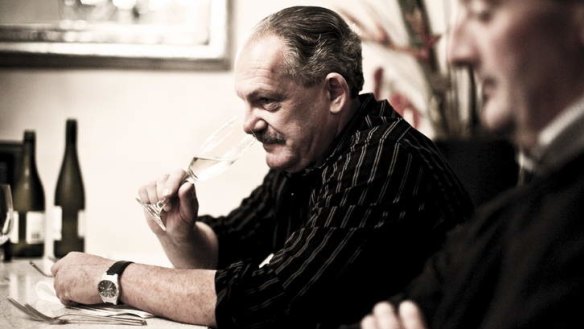Slow road south
Ed Carr headed inevitably to Tasmania for the fruit to make top bubblies, Chris Shanahan writes

Australia's sparkling wine king, Ed Carr, first put bubbles in wine in 1977. Charged with sorting out ''some issues with secondary fermentation'', Carr, a microbiologist, joined senior winemaker Pam Dunsford at Seaview's Glenloth winery.
''We got through, though I was straight out of uni,'' Carr recalls. At the time, Dunsford made the base wines for Seaview ''champagne'', as it was then called. The wines were finished by Norm Walker at Seaview's sparkling cellars in the Adelaide suburb of Magill.
Today, that division of labour seems as foreign as the grapes our sparkling makers used just a generation ago.
The classic sparkling varieties, pinot noir and chardonnay, were little planted in Australia at the time and our sparkling makers used neutral grape varieties. They intentionally created a blank canvas on which to paint the aromas, flavours and textures from bottle fermentation and maturation on spent yeast cells.
Carr recalls using muscadelle, chenin blanc and even a touch of grenache. ''Pinot noir and chardonnay didn't come on to our agenda until the late '80s,'' he says. ''But Seaview 1990 was a big year for us, our first pinot noir chardonnay.''
The fruit came from Wynns vineyards (also part of the Penfolds group) at Coonawarra and Padthaway.
In 1986, Carr relocated to the new sparkling wine cellars in the Barossa. The fruit from Coonawarra and Padthaway, however, fell a long way short of ideal, largely because both regions were too warm. By this time, Carr says, sourcing fruit occupied his mind, and a mid-1980s trip with fellow winemaker Rob Gibson opened Carr's eyes to the potential offered by cooler growing areas.
They swung through the Yarra Valley, where chandon was beginning, to high, cool sites in the Pyrenees and on to Tasmania. Here they met with Julian Alcorso at Moorilla Estate, near Hobart, and Andrew Pirie at Pipers Brook, near Launceston. Though it would a decade before Carr sourced fruit from Tasmania, he decided ''this was the place to be''.
About the same time, Seppelt became part of the Penfolds group, bringing Carr into contact with wines made by Warren Randall and Ian McKenzie from Tumbarumba, NSW, and Drumborg, southwestern Victoria.
The two regions made different styles, Carr recalls - those from young, highly cropped vines at Tumbarumba being less intense than those from mature vines in the very cold Drumborg region.
In 1994, Hardys recruited Carr as head of sparkling wine. Carr says at that time they lagged the other large wine companies in sparkling winemaking, despite runaway success with the Sir James brand.
The company wanted to make top sparkling wines and poured in the resources to achieve the goal. About the same time, it bought a substantial Yarra Valley vineyard, near Gembrook. The vineyard had been set up for sparkling wine by well-known viticulturist David Paxton. It belonged to a syndicate of companies, including Hardys, and until 1994 sold fruit to its shareholders.
However, from 1995 Hardys, now the sole owner, took all the fruit for its upmarket sparklers. In the same year, it planted large areas of pinot noir along the Riverland to feed its big-volume, cheaper Omni brand.
And in 1995, Carr took his first small batches of Tasmanian fruit. ''I visited Tassie and let it be known we were after grapes and would see what turned up,'' he says.
Hardys paid good prices, Carr says, and over the next few years the grape volumes and range of vineyards they sourced from grew rapidly. Table wines, particularly chardonnay, came on the agenda, too.
In 2001, Hardys bought the Bay of Fires winery and vineyard. Until then, Tasmanian contractors pressed, chilled and shipped juice to Carr in Adelaide. But after the purchase, Bay of Fires made all of the group's Tasmanian table wines on site and took over the pressing, chilling and shipping juice for sparkling wine production, which remains under Carr's control at Tintara.
Carr says it took 10 to 15 years ''to get a picture'' of what worked and where. Many sites can be managed for both table and sparkling wine, he says. But for sparkling, sourcing moved south to include vineyards along the east coast, near Swansea and Cranbrook, the Coal River Valley, and the Meadowbank vineyard, on the Derwent near New Norfolk, west of Hobart.
Winemaking follows traditional French techniques, including prolonged ageing on yeast lees in bottle following the secondary fermentation. This vital stage of sparkling production adds subtly to the aroma, flavour, structure and bubble size of sparkling wine.
Carr says when he began making top-shelf sparklers for Hardys, he aimed for four years' maturation on yeast lees before release. But by holding museum stock for longer periods, he's learnt that the best wines, particularly those from Tasmania, develop beautifully with much longer maturation. This led to the release of a late disgorged product, matured on lees for 10 years.
Carr believes it's difficult to separate the characters derived during yeast autolysis from aged varietal character and other winemaking inputs, such as maturation of base wines in oak barrels before the secondary fermentation. However, he says, ''it's the total mix that matters''.
As to the tiny bubbles in good sparkling wine, he says he doesn't understand the cause chemically, but it relates to surface tension and long maturation on yeast lees. He observes a clear pattern between bubble size and length of maturation.
Carr sees a clear distinction between the minerality of Tasmanian sparkling wine and the fruitier quality of mainland fruit - a quality making it well suited to great bottle ageing.
His style for both House of Arras, the flagship Tasmanian brand, and Bay of Fires includes fermentation and maturation of components in oak barrels and full malolactic fermentation.
Future tweaking will include a little more reserve wine blended into the base wines and the influence of new plantings, yet to bear fruit.